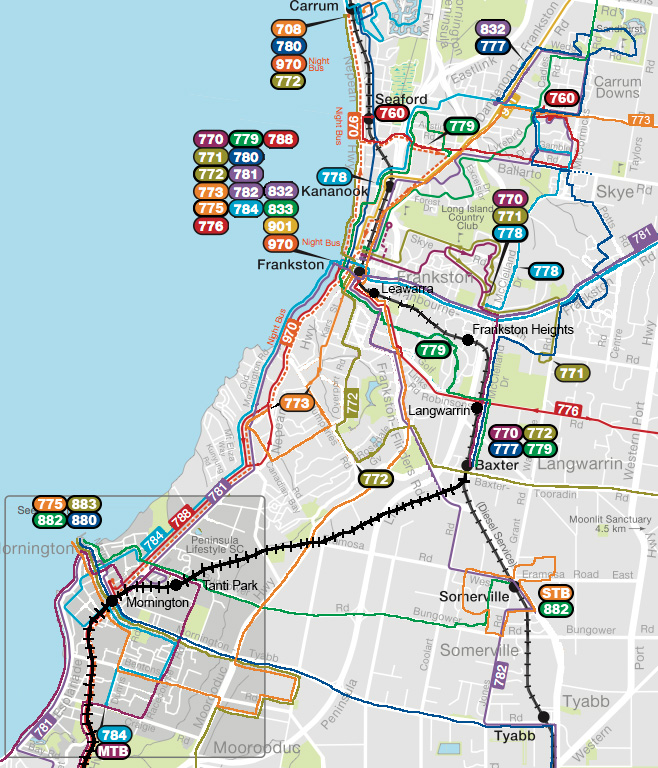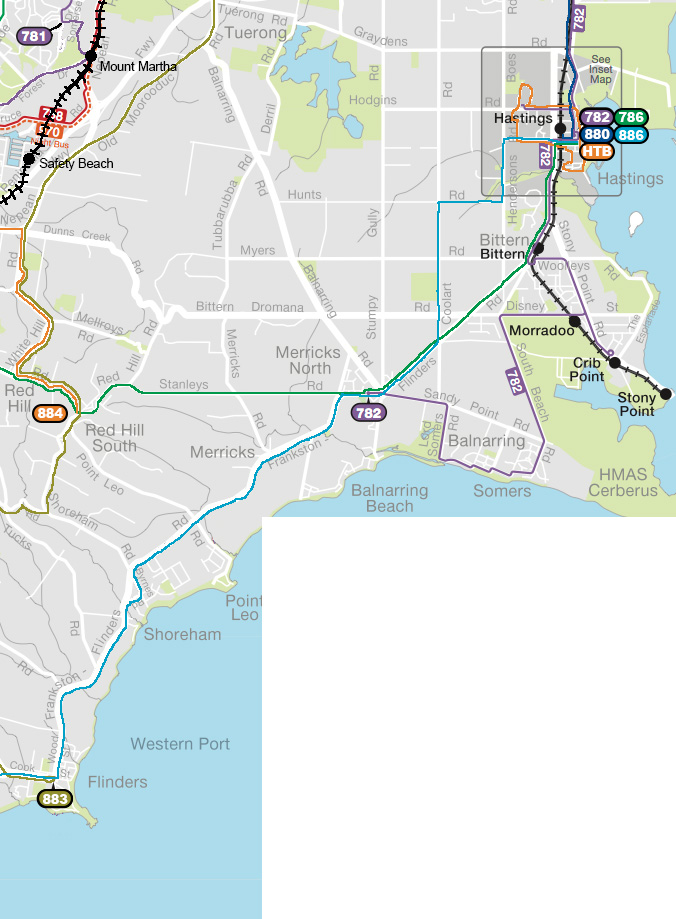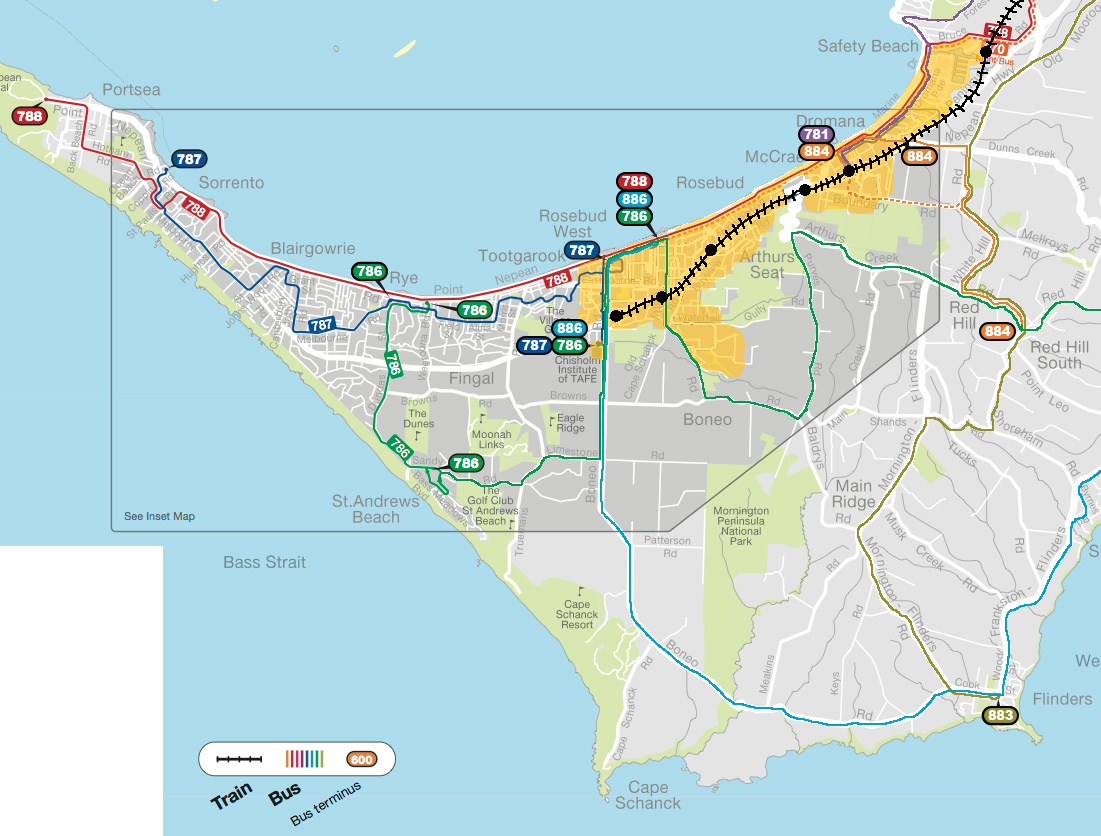Stage 1
Stage 1 (2024-2027) will focuses on improving public transport on the Peninsula itself, better connecting communities within the Peninsula, and laying the foundations for extensing services to Melbourne. Upgrades to the Frankston and Stony Point lines, and vast upgrades to the Peninsula's bus network, will be built at this stage.
Stony Point line duplication
Timeframe: 2025-2027, 2029-2031, 2035-2037
The entire Stony Point line is single-track. This limits how many services can run on it. Duplication to Hastings, and the construction of a crossing loop between Bittern and Crib Point stations, will greatly boost capacity. This project will include the upgrade of Baxter, Somerville, Hastings and Crib Point stations to Staffed stations, and the construction of sheds in Crib Point and later Hastings to stable trains.
This project will be completed across all 3 stages. In Stage 1, 3 crossing loops would be built alongside Crib Point stabling and the Kananook maintenance facility. In Stage 2, full duplication would be built between Frankston and Somerville, and a new crossing loop would be built immediately north of Hastings station. In Stage 3, full duplication would extend to Hastings, the Bittern-Morradoo crossing loop would be extended to Crib Point, and a new stabling yard would be built in Hastings.
Duplicating the Stony Point line will allow its services to match those of the Peninsula Rail Link, providing the east coast with the same level of service as the west coast.
Platform 1 at Frankston station would need to be rebuilt as a through platform to allow Stony Point trains to depart and arrive at the same time.
New regional train fleet
Timeframe: 2025-2037
A brand new fleet of trains would be introduced to the Rosebud, Stony Point and Gippsland lines. These new trains would have special doorways next to the driver cab that would allow passengers to walk between carriage sets while the train is moving, without having to leave the train. These trains would be capable of speeds up to 160km/h, and have high-capacity signalling installed in them. These railcars would be battery-electric, with their batteries charged by overhead chargers at termini (Stony Point, Crib Point, Rosebud and later Hastings), and while running under the overhead wires of the suburban network.
These trains would provide comfort, speed and reliability to the Peninsula and Gippsland. They would also be able to divide or couple together partway through a trip, without forcing passengers to board specific carriages beforehand. Solar-powered interiors would also save fuel and allow the trains to travel further on one tank.
These trains would provide comfort, speed and reliability to the Peninsula and Gippsland. They would also be able to divide or couple together partway through a trip, without forcing passengers to board specific carriages beforehand. Solar-powered interiors would also save fuel and allow the trains to travel further on one tank.
Southland-Mentone triplication
Timeframe: 2026-2028
In order for peninsula trains to run to Melbourne as quickly as possible, they will need to overtake 2 suburban trains. The triple track between Moorabbin and Caulfield will allow for one such overtaking move, but further triplication will be needed for the second. This will be done between Mentone and Southland.
High-Capacity Signalling
Timeframe: 2026-2027
Another requirement for future Peninsula trains to run as V/Line expresses to the city is to install high-capacity signalling on the Frankston line. This would allow trains to safely run closer together.
Moving-block signalling, in which the signalling technology is on the train instead of lineside, can allow for up to 36 trains to run on a line every hour, and is the best high-capacity signalling technology currently available. This technology is currently being rolled out on the Pakenham, Cranbourne and Sunbury lines as part of the Metro Tunnel project.
Bus upgrades
A major overhaul of Frankston's and the Mornington Peninsula's bus networks would be undertaken as part of the project. Routes would be upgraded to run every 20 minutes, and run to more places, such as from Hastings to Mornington and Rosebud, and from Frankston to Cranbourne via Carrum Downs. In addition, many routes that terminate in Frankston would be merged to form larger routes that go through Frankston station without requiring passengers to change at Frankston.
SMARTBus route 901 would continue to terminate at Frankston, but would have its frequency boosted to every 10 minutes on weekdays and every 20 minutes on weekends.



